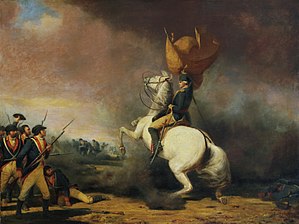
Back Slag van Princeton Afrikaans Битка при Принстън Bulgarian Batalla de Princeton Catalan Slaget ved Princeton Danish Schlacht von Princeton German Batalla de Princeton Spanish Princetonin taistelu Finnish Bataille de Princeton French Batalla de Princeton Galician Pertempuran Princeton ID
| Battle of Princeton | |||||||
|---|---|---|---|---|---|---|---|
| Part of the New York and New Jersey campaign | |||||||
 Washington Rallying the Americans at the Battle of Princeton by William Ranney (1848) | |||||||
| |||||||
| Belligerents | |||||||
|
|
| ||||||
| Commanders and leaders | |||||||
|
|
| ||||||
| Strength | |||||||
|
4,500 35 guns[2] |
1,200 6–9 guns[3] | ||||||
| Casualties and losses | |||||||
|
25–44 killed 40 wounded[4][5] |
50–100 killed 58–70 wounded 194–280 captured[6][7] | ||||||
Location within USA Midwest and Northeast | |||||||
The Battle of Princeton was a battle of the American Revolutionary War, fought near Princeton, New Jersey on January 3, 1777, and ending in a small victory for the Colonials. General Lord Cornwallis had left 1,400 British troops under the command of Lieutenant Colonel Charles Mawhood in Princeton. Following a surprise attack at Trenton early in the morning of December 26, 1776, General George Washington of the Continental Army decided to attack the British in New Jersey before entering the winter quarters. On December 30, he crossed the Delaware River back into New Jersey. His troops followed on January 3, 1777. Washington advanced to Princeton by a back road, where he pushed back a smaller British force but had to retreat before Cornwallis arrived with reinforcements. The battles of Trenton and Princeton were a boost to the morale of the patriot cause, leading many recruits to join the Continental Army in the spring.
After defeating the Hessians at the Battle of Trenton on the morning of December 26, 1776, Washington withdrew back to Pennsylvania. He subsequently decided to attack the British forces before going into winter quarters. On December 29, he led his army back into Trenton. On the night of January 2, 1777, Washington repulsed a British attack at the Battle of the Assunpink Creek. That night, he evacuated his position, circled around General Cornwallis' army, and went to attack the British garrison at Princeton.
On January 3, Brigadier General Hugh Mercer of the Continental Army clashed with two regiments under the command of Mawhood. Mercer and his troops were overrun, and Mercer was mortally wounded. Washington sent a brigade of militia under Brigadier General John Cadwalader to help them. The militia, on seeing the flight of Mercer's men, also began to flee. Washington rode up with reinforcements and rallied the fleeing militia. He then led the attack on Mawhood's troops, driving them back. Mawhood gave the order to retreat, and most of the troops tried to flee to Cornwallis in Trenton.
In Princeton, Brigadier General John Sullivan encouraged some British troops who had taken refuge in Nassau Hall to surrender, ending the battle. After the battle, Washington moved his army to Morristown, and with their third defeat in 10 days, the British evacuated Central Jersey. The battle (while considered minor by British standards)[8][9] was the last major action of Washington's winter New Jersey campaign.
- ^ Newton, 2011, pp. 47–48
- ^ Fischer, 2006, p. 404
- ^ Fischer, 2006, p. 404
- ^ Lengel, 2005, p. 208
- ^ Ketchum, 1999, p. 373
- ^ Stryker, 1898, pp. 308–309
- ^ Boatner, 1966, p. 893
- ^ "Battle of Princeton" Xtimeline
- ^ "Battle of Princeton" TotallyHistory

